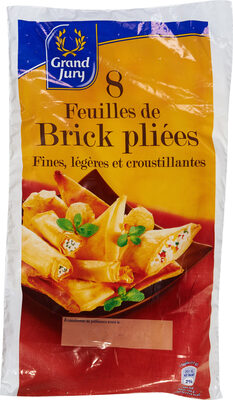8 Feuilles de brick pliées - Carrefour - 136 g
Important note: this product is no longer sold. The data is kept for reference only. This product does not appear in regular searches and is not taken into account for statistics.
This product page is not complete. You can help to complete it by editing it and adding more data from the photos we have, or by taking more photos using the app for Android or iPhone/iPad. Thank you!
×
Some of the data for this product has been provided directly by the manufacturer Carrefour.
Barcode: 3560070454778 (EAN / EAN-13)
Common name: Feuilles de brick.
Quantity: 136 g
Brands: Carrefour
Categories: Plant-based foods and beverages, Plant-based foods, Cereals and potatoes, Cereals and their products, Pie dough, Brick sheets
Labels, certifications, awards:
Green Dot, Made in France
Origin of the product and/or its ingredients: Ce produit est fabriqué en France à partir de blé origine France.
Producer: Fabriqué en France par EMB 95268C pour Interdis.
Traceability code: EMB 95268C - Garges-lès-Gonesse (Val-d'Oise, France)
Stores: Carrefour
Countries where sold: France
Matching with your preferences
Environment
Packaging
Transportation
Other information
Other information: Fines, Légères et Croustillantes
Preparation: Vous pouvez varier les formes : aumônières, cigares, corolles ou samoussas (voir techniques de pliage). Les feuilles de brick préalablement badigeonnées avec de l'huile ou du beurre fondu peuvent aussi être superposées, pour être utilisées en fond de tarte par exemple. Si votre garniture est très généreuse, doublez la feuille de brick. Conseils de pliage pliage en samoussa 1 : Dépliez la feuille de brick. 2 : Coupez-la en deux et rabattez la partie arrondie sur le bord. 3 : Déposez la farce à une extrémité. 4 : Rabattez la feuille avec la farce à l'intérieur. 5 : Rabattez dans l'autre sens pour former un triangle et répétez l'opération jusqu'à ce qu'il ne reste de place que pour un seul triangle. 6 : Vous pouvez soit replier la dernière partie vide à l'intérieur du triangle que vous avez formé, soit badigeonner le dernier triangle vide de jaune d'œuf battu et le rabattre. pliage en cigare 1 : Dépliez la feuille de brick et coupez-la en deux. Placez la farce dans le coin gauche, pas trop près des bords. 2 : Rabattez les bords jusqu'au milieu de la feuille. 3 : Roulez la partie contenant la farce de façon à former un tube 4 : Badigeonnez de jaune d'œuf battu l'extrémité de la feuille et rabattez-la sur le cigare ainsi formé. pliage en aumônière 1 : Dépliez la feuille de brick et gardez-la entière. 2 : Placez la farce au centre et relevez délicatement les bords. 3 : Utilisez de la ficelle de cuisine pour faire un nœud en faisant attention à ne pas casser la feuille de brick. Après cuisson, la ficelle peut être remplacée par un brin de ciboulette ou un pic en bois pour un rendu plus raffiné.
Recipe idea: Recette facile : Samoussa au boeuf express Préparation 10 min. Pour 16 samoussas : 8 feuilles de brick Grand Jury, 150g de boeuf haché, 1 oignon, 1 branche de thym, 1 cuillère à soupe de curry, 1 cuillère à soupe d'huile d'olive, sel, poivre Préparation : Emincez l'oignon et faites-le revenir doucement dans l'huile avec la viande émiettée. Ajoutez le thym, le curry, salez, poivrez et laissez cuire 3 min. Suivez le mode explicatif du pliage des samoussas ci-dessous. Cuisson : Faites dorer vos samoussas quelques minutes en surveillant bien la cuisson à la friteuse ou à la poêle dans un bain d'huile bien chaude ou au four 7 min à 180°C.
Warning: Ne pas utiliser le papier paraffiné qui se trouve entre les feuilles de brick pour la cuisson.
Conservation conditions: A consommer de préférence avant le : voir sur la face avant du sachet. A conserver entre 0°C et +8°C. Afin de conserver les qualités organoleptiques de votre produit, nous vous conseillons de bien refermer le sachet après chaque utilisation.
Customer service: Interdis - TSA 91431 - 91343 MASSY Cedex - France
Report a problem
Data sources
Product added on by kiliweb
Last edit of product page on by org-carrefour.
Product page also edited by carrefour, desan, openfoodfacts-contributors, roboto-app, yuka.ZEk1Wk1QNDVsdFl3cWMxaHhrNksydXhhMVlLN2JHNlhNTFVjSVE9PQ.








